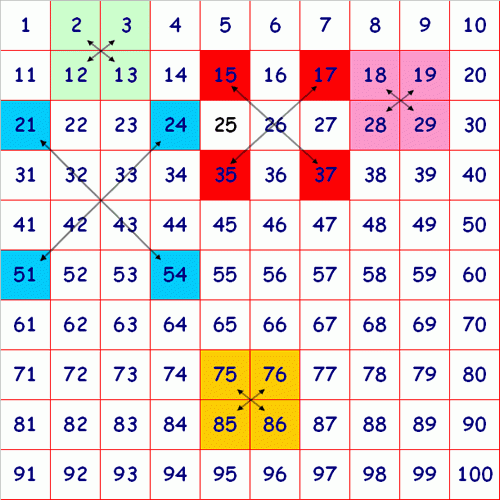Diagonal Sums
In this 100 square, look at the green square which contains the numbers 2, 3, 12 and 13. What is the sum of the numbers that are diagonally opposite each other? What do you notice?
Problem
Here is a $100$ square with some of the numbers shaded:

Look at the green square which contains the numbers $2, 3, 12$ and $13$.
Do you notice anything about the sum of the numbers that are diagonally opposite each other?
Look at the pink square.
What happens this time when you look at the numbers diagonally opposite each other?
What about the yellow square?
You could try with other squares which have four numbers in them.
Can you find a reason why what you notice, happens?
Look at the squares shaded red. They form the corners of a large $3$ by $3$ square.
If you add the numbers diagonally opposite each other, what do you notice with this larger square?
Can you find a reason why what you notice, happens?
What happens for squares of different sizes?
You may like to print off this 100 square to try out some different squares of numbers.
Getting Started
How do the numbers at the corners of the square compare with each other?
For example, what is the difference between the two numbers at the "top" corners of the square? And the difference between the two numbers at the "bottom" corners of the square?
You may like to print off this 100 square to try out some different squares of numbers.
Student Solutions
David sent in this quite neat explanation:
The numbers that are diagonal to each other add up to make the same number because you're adding one that's lower or higher by 1, 2 or 3 to the number beside it.
For example, in a 3x3 square, the number in the top right is 2 more than the number in the top left. The number in the bottom left is 2 less than the number in the bottom right. So when we add the top left and bottom right, and the top right and bottom left, we get the same total.
Esther who is 8 used letters to stand for the numbers (we call this algebra) and shows why the totals are the same:
I have found out that the sum of each diagonal pair in a square is always the same as the other in the same colour. We can write any square out like this:
| N | N+1 |
| N+10 | N+11 |
For a 3x3 square the result was the same and the sum is twice the number in the middle:
| N | N+2 | |
| N+11 | ||
| N+20 | N+22 |
The 4x4 square looks like this:
| N | N+3 | ||
| N+11 | N+12 | ||
| N+21 | N+22 | ||
| N+30 | N+33 |
The sum of the opposite corners is 2N+33. The opposite corners of the small square in the middle also add up to the same number.
A 5x5 table looks like this:
| N | N+4 | |||
| N+22 | ||||
| N+40 | N+44 |
Thank you Esther, that's a very clear way of explaining.
Even if you haven't met algebra, you can still use ordinary words as David did. Well done!
Teachers' Resources
Why do this problem?
This problem demonstrates the power of the 100 square in helping pupils to recognise number properties and in beginning to reason carefully. The latter, at this level, can be considered as a form of proof. It also gives an opportunity for some to use an intuitive form of algebra.
Possible approach
With all the children together looking at a large display of a 100 square and then choosing the 2, 3, 12, 13 square (without the multiplying arrows) and sharing all the observations that the pupils make. Some of these may be at a simple straightforward level; "the units of the ones above are the same", "the total is 30".
When many observations have been made the idea of multiplying opposite corners could be suggested - if it has not already occurred.
This is now beginning to move into slightly harder realms and it may (according to the abilities of the pupils) be a good time to give out copies of the activity.
Key questions
If pupils have, in the introduction given a total for the four numbers it would be good to ask them how they added up the four numbers.
When the pupils are working on the activity it would be good to ask what they are noticing.
It may be appropriate to ask the to explain further how they know the things they have observed.
Possible extension
Ask for a proof that their observations will always happen?
Can they predict what to do for a 6 by 6 square?
Thank you to Mark Burdass, a teacher at Harlands Primary School in Haywards Heath, who suggested the following further extension tasks:
- What about the corners of an oblong? What happens when you add these?
- What about the corners of a tilted square? What happens when you add these?
- Can you find any other quadrilaterals (such as parallelograms, rhombuses, trapeziums or kites) that behave in the same way?
Possible support
The printable version of the 100 square might be useful for children to try out a variety of diagonal sums.
